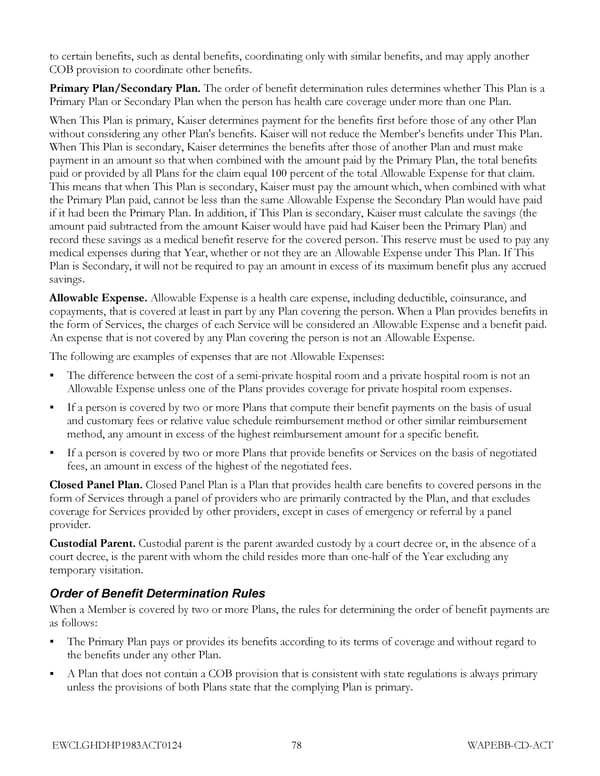to certain benefits, such as dental benefits, coordinating only with similar benefits, and may apply another COB provision to coordinate other benefits. Primary Plan/Secondary Plan. The order of benefit determination rules determines whether This Plan is a Primary Plan or Secondary Plan when the person has health care coverage under more than one Plan. When This Plan is primary, Kaiser determines payment for the benefits first before those of any other Plan without considering any other Plan's benefits. Kaiser will not reduce the Member’s benefits under This Plan. When This Plan is secondary, Kaiser determines the benefits after those of another Plan and must make payment in an amount so that when combined with the amount paid by the Primary Plan, the total benefits paid or provided by all Plans for the claim equal 100 percent of the total Allowable Expense for that claim. This means that when This Plan is secondary, Kaiser must pay the amount which, when combined with what the Primary Plan paid, cannot be less than the same Allowable Expense the Secondary Plan would have paid if it had been the Primary Plan. In addition, if This Plan is secondary, Kaiser must calculate the savings (the amount paid subtracted from the amount Kaiser would have paid had Kaiser been the Primary Plan) and record these savings as a medical benefit reserve for the covered person. This reserve must be used to pay any medical expenses during that Year, whether or not they are an Allowable Expense under This Plan. If This Plan is Secondary, it will not be required to pay an amount in excess of its maximum benefit plus any accrued savings. Allowable Expense. Allowable Expense is a health care expense, including deductible, coinsurance, and copayments, that is covered at least in part by any Plan covering the person. When a Plan provides benefits in the form of Services, the charges of each Service will be considered an Allowable Expense and a benefit paid. An expense that is not covered by any Plan covering the person is not an Allowable Expense. The following are examples of expenses that are not Allowable Expenses: The difference between the cost of a semi-private hospital room and a private hospital room is not an Allowable Expense unless one of the Plans provides coverage for private hospital room expenses. If a person is covered by two or more Plans that compute their benefit payments on the basis of usual and customary fees or relative value schedule reimbursement method or other similar reimbursement method, any amount in excess of the highest reimbursement amount for a specific benefit. If a person is covered by two or more Plans that provide benefits or Services on the basis of negotiated fees, an amount in excess of the highest of the negotiated fees. Closed Panel Plan. Closed Panel Plan is a Plan that provides health care benefits to covered persons in the form of Services through a panel of providers who are primarily contracted by the Plan, and that excludes coverage for Services provided by other providers, except in cases of emergency or referral by a panel provider. Custodial Parent. Custodial parent is the parent awarded custody by a court decree or, in the absence of a court decree, is the parent with whom the child resides more than one-half of the Year excluding any temporary visitation. Order of Benefit Determination Rules When a Member is covered by two or more Plans, the rules for determining the order of benefit payments are as follows: The Primary Plan pays or provides its benefits according to its terms of coverage and without regard to the benefits under any other Plan. A Plan that does not contain a COB provision that is consistent with state regulations is always primary unless the provisions of both Plans state that the complying Plan is primary. EWCLGHDHP1983ACT0124 78 WAPEBB-CD-ACT
 Kaiser Permanente NW CDHP EOC (2024) Page 84 Page 86
Kaiser Permanente NW CDHP EOC (2024) Page 84 Page 86